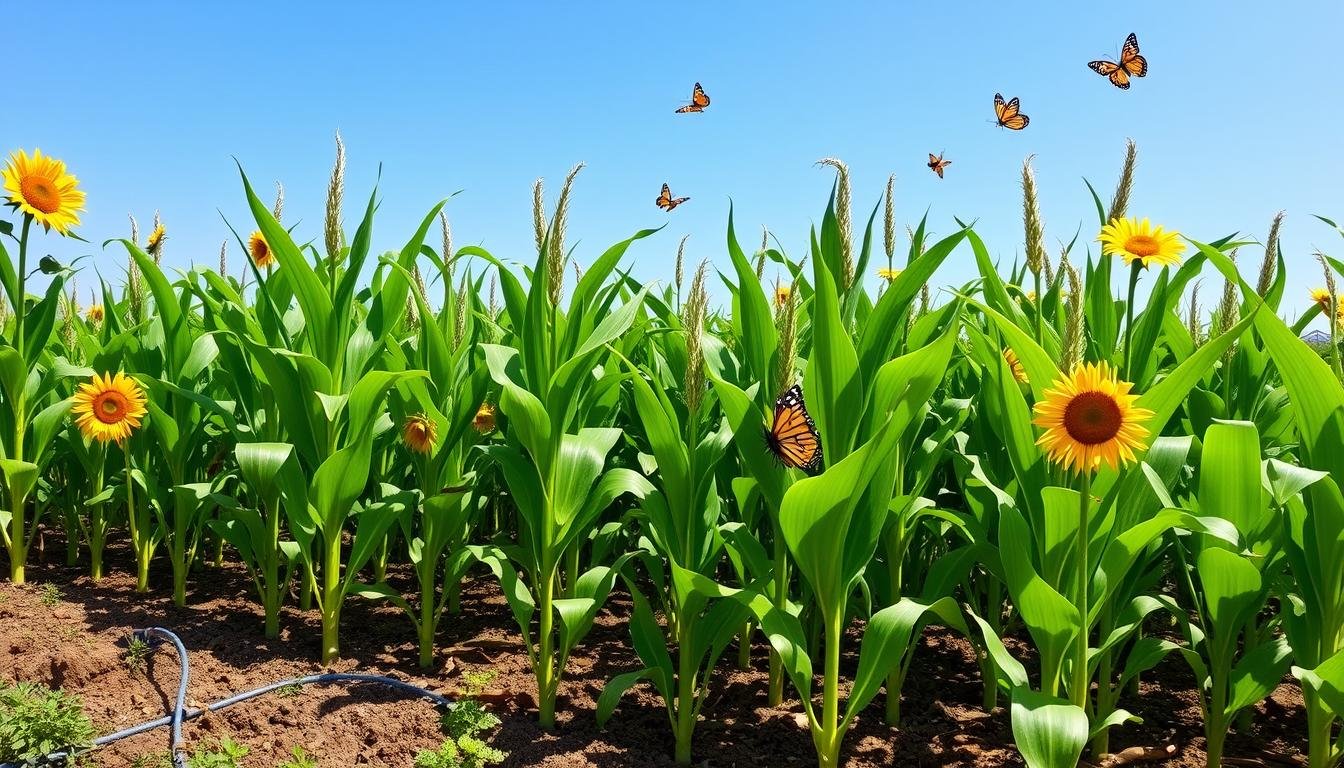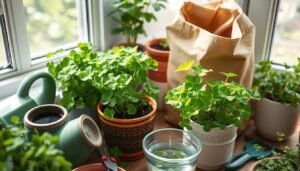corn plant care is rewarding and requires care. Proper *corn plant care* is key to a good harvest. By taking care of your plants, you can enjoy sweet corn that’s better than store-bought.
Knowing what your corn plants need is important. This includes the right soil, water, sunlight, and pest control. Whether your garden is small or large, there are *care tips for corn plants* to help them grow well. A well-cared-for corn patch can give you lots of corn and improve your gardening skills.
Starting seeds indoors or directly outdoors is important. If you’re short on space, you can fit about 15 corn plants in a 3 x 5-foot bed. This guide will help you grow corn successfully, for more yield and fun.
Table of Contents
Understanding Corn Plant Growth Stages
Knowing the growth stages of corn plants is key to getting a good harvest. Corn plants go through three main stages: seed germination, vegetative growth, and the reproductive stage. Each stage is important for the plant’s health and how well it grows.
Seed Germination
Seed germination is the start of a corn plant’s life. It happens when the soil is between 68 and 86°F. This is when the seeds sprout.
After germination, the plant starts to grow. It absorbs water and nutrients from the soil. This is shown by the coleoptile breaking through the soil, called VE (emergence).
Vegetative Growth
After germination, the plant grows leaves. It usually has about 20 leaves by the end. The first leaves are important for photosynthesis and a strong root system.
Growth depends on soil moisture and nutrients. Drought can slow growth and reduce yields. As the plant grows, it adds a new leaf every 3 to 4 days. The V5 and V6 stages are key for nitrogen and kernel row formation.
Reproductive Stage
In the reproductive stage, the plant makes kernels. This stage has several sub-stages, like silking (R1), blister (R2), and dough (R4). Each stage has its own signs, like silk development and kernel moisture.
Pollination mainly happens during R1. This is a critical time for a good harvest. Knowing these stages helps in managing the plant well.
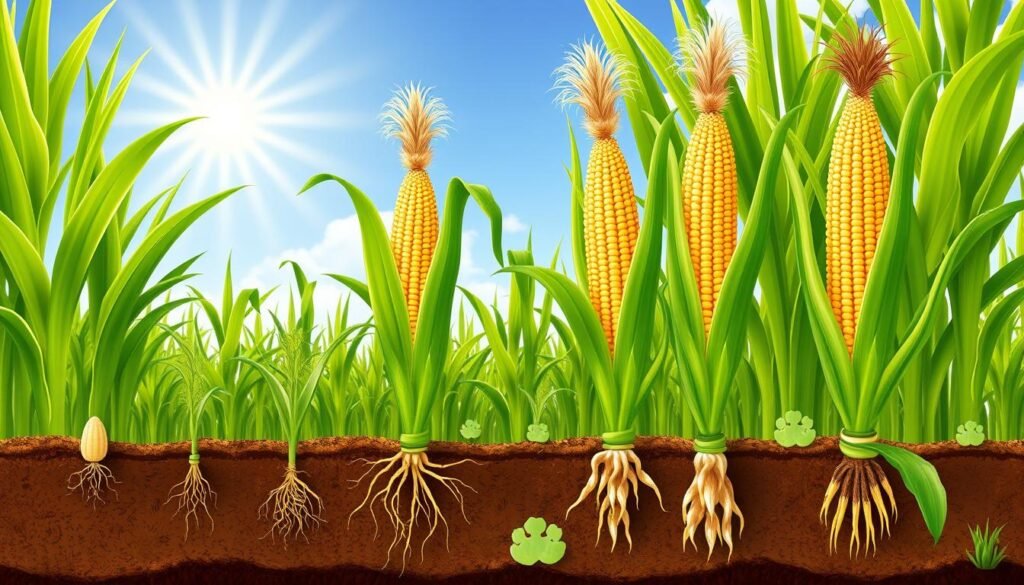
| Growth Stage | Description | Days After Planting | Key Features |
|---|---|---|---|
| VE | Emergence | 115-120 GDD | Coleoptile reaches the surface |
| V5-V6 | Vegetative Growth | Approximately 50 GDD | Critical nitrogen uptake and kernel row determination |
| R1 | Silking | +50-55 days from silking | Silks appear, indicating pollination period |
| R3 | Milk Stage | 20 days after silking | Kernels turn yellow and milky white |
| R6 | Physiological Maturity | ~60 days after silking | Kernels reach maximum dry weight |
Corn Plant Soil Requirements
Knowing what soil your corn plant needs is key for it to grow well. Corn does best in soil that is fertile and drains well. The ideal soil pH is between 6.0 and 6.8. This helps nutrients get to the roots and supports growth.
Soil pH and Composition
Keeping the soil pH right is important for your corn plant’s health. The soil should have organic materials like compost to make it fertile and structured. This helps the plant absorb nutrients well, which is important for its growth.
Here’s a simple breakdown of the necessary soil composition:
| Component | Percentage |
|---|---|
| Loamy Soil | 40% |
| Organic Matter | 30% |
| Sandy Soil | 20% |
| Clay Soil | 10% |
Importance of Drainage
Good drainage is key to stop root rot in your corn plants. They need consistent moisture but can’t handle being waterlogged. Using a well-draining soil mix is essential for your plants’ health.
Consider using pots with drainage holes to remove excess water. This ensures your plants have the best chance to grow strong roots.
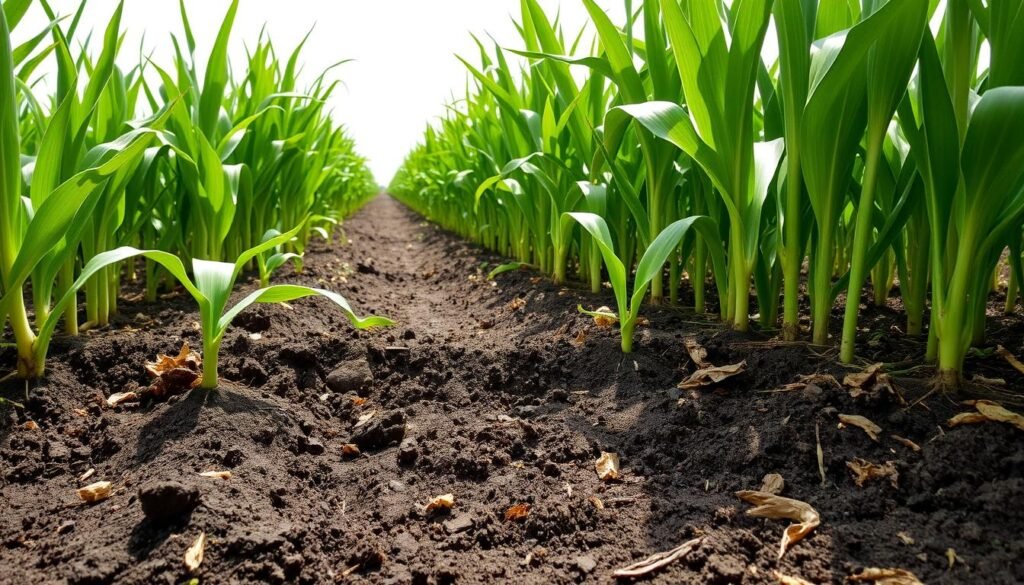
Corn Plant Watering Techniques
Watering your corn plants right is key to their health and growth. Knowing the watering frequency helps avoid underwatering and overwatering. This guide will show you how often to water and how to spot watering problems.
Ideal Watering Frequency
Corn plants usually need watering every 7-10 days. But, this can change based on light and humidity. In hot months, they might need more water to stay moist. Use water at room temperature, let it sit for 24 hours first.
Check the soil moisture often. Wait until the top 1-2 inches of soil dries before watering again.
Signs of Underwatering and Overwatering
Watching your corn plants’ watering needs is important. Signs of underwatering include:
- Dry soil
- Drooping leaves
- Brittle brown leaf tips
- Slow or nonexistent growth
Signs of overwatering are:
- Consistently moist or soggy soil
- Yellowing leaves
- Root rot
- Leaf drop
Using a well-draining potting mix and ensuring good drainage can help. Adjust your corn plant watering based on light and temperature to keep them healthy.
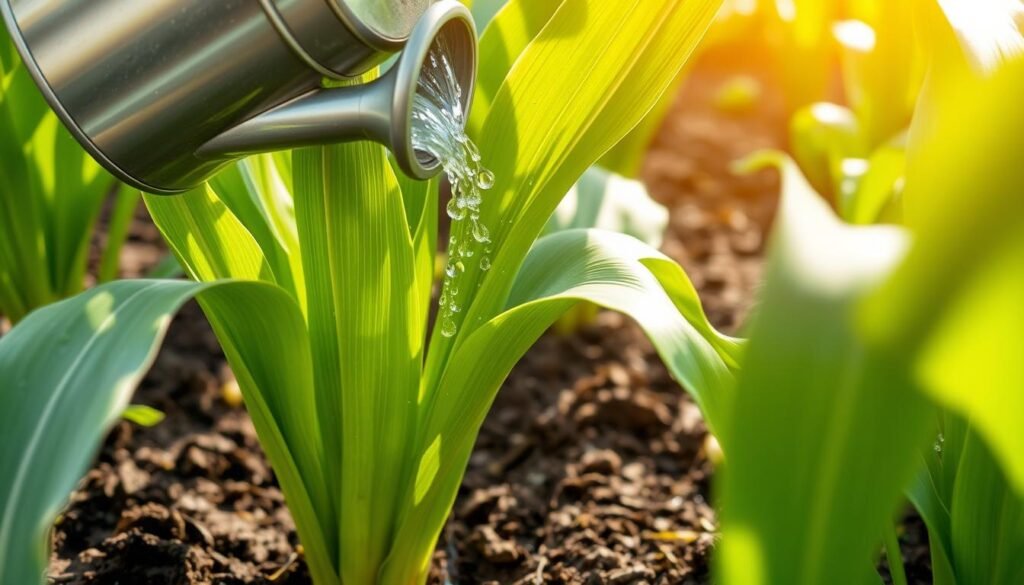
| Condition | Watering Schedule | Signs |
|---|---|---|
| Underwatering | Water every 10-12 days | Dry soil, wilting leaves, brittle tips |
| Ideal | Water every 7-10 days | Soil slightly moist, healthy leaves |
| Overwatering | Water every 2-3 weeks | Yellow leaves, soggy soil, leaf drop |
Corn Plant Sunlight Needs
For corn to grow well, it needs lots of sunlight. Knowing how much sunlight it needs is key. The right spot for your corn ensures it gets enough sun, which is vital for its growth.
Choosing the Right Location
Corn needs a sunny spot with at least six to eight hours of direct sun daily. Pick a place where tall buildings or trees won’t block the sun. This ensures your corn grows strong and yields well.
Impact of Shade on Corn Growth
Shade can really slow down corn growth. While they can handle some shade, too little sun limits their growth and lowers yields. Keep an eye out for any shade sources and fix them to meet your corn’s sunlight needs.
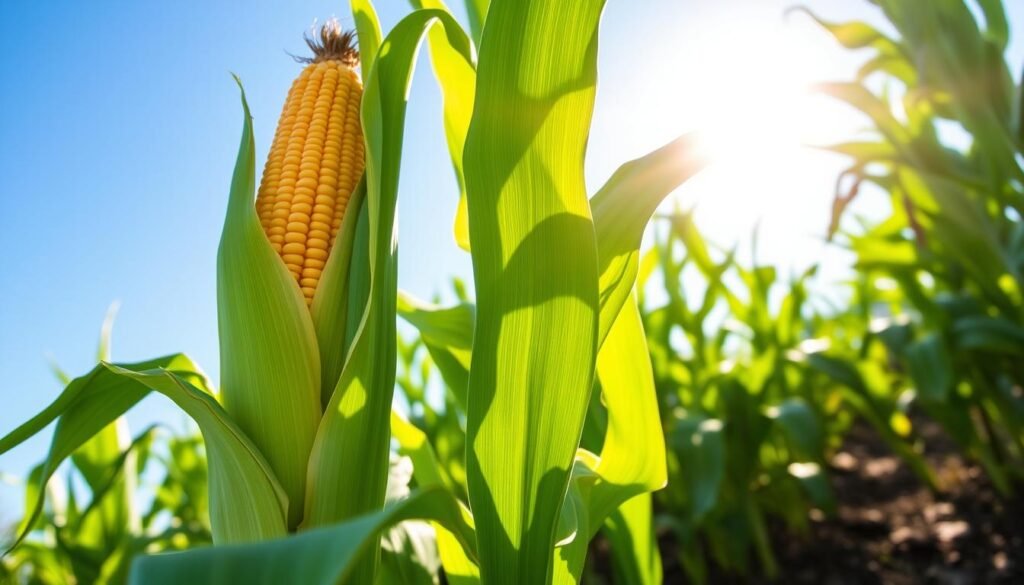
Corn Plant Fertilizer Application
Proper fertilizer application is key for healthy corn plants. You need to pick the right fertilizer types and plan a fertilization schedule. This ensures the plants get the nutrients they need as they grow.
Types of Fertilizers
Choosing the right corn plant fertilizer is important. Look for balanced options that give essential nutrients. Here are some common types:
- Liquid Fertilizers: A balanced liquid fertilizer like a 20-20-20 mix promotes even growth.
- Granular Fertilizers: These release nutrients slowly and need less frequent application.
- Organic Fertilizers: Compost or well-rotted manure boosts soil health and provides nutrients.
Timing Your Fertilization Schedule
Your fertilization schedule should match the corn plant’s growth phases. Regular feeding boosts yield. Apply corn plant fertilizer:
- Monthly during the growing season for liquid fertilizers.
- At quarter strength when watering, to avoid salt buildup.
- Before major growth stages, like the start of the vegetative phase.
Following a good fertilization schedule helps corn plants get the nutrients they need. This prevents overfertilization and ensures optimal growth and health.
Managing Corn Plant Pests and Diseases
Keeping your corn plants healthy means watching out for pests and diseases. Spotting common threats early and using good pest management can boost your crop’s yield and quality. This part talks about the pests and diseases you might see and how to prevent them.
Common Pests to Monitor
Many pests can harm your corn. It’s important to check your plants often to catch these pests early. Look for:
- Spider mites
- Mealybugs
- Scale insects
These pests love warm weather and can hurt your corn plants a lot if not stopped. Keeping the temperature between 65-80°F (18-27°C) helps your plants grow well and keeps pests away.
Preventive Measures Against Diseases
Diseases can come from old crop leftovers, bad weather, or not enough nutrients. Good pest management means knowing about common corn diseases like:
- Northern corn leaf blight (NCLB)
- Gray leaf spot (GLS)
- Southern Rust
- Anthracnose leaf blight
It’s key to take steps to prevent diseases. Here are some ways to do it:
- Change what you grow to nonhost plants to reduce soil pathogens.
- Choose the right hybrid for your area, focusing on disease resistance.
- Use fungicides wisely, like during the tasseling stage, to protect your yield.
Checking your corn plants often helps you spot problems early. This lets you treat diseases quickly if needed. Being proactive in pest control helps keep your crops healthy and productive.
| Pest/Disease | Symptoms | Management Strategies |
|---|---|---|
| Spider Mites | Stippling on leaves, webbing | Regular inspections, insecticidal soaps |
| Mealybugs | White cottony masses, stunted growth | Manual removal, neem oil |
| Gray Leaf Spot | Greyish lesions on leaves | Crop rotation, fungicides |
| Northern Corn Leaf Blight | Long, dark stripes on leaves | Fungicides, resistant hybrids |
Corn Plant Care: Tips for a Successful Harvest
To get a good harvest, knowing how to care for corn plants is key. This means spacing them right and using mulch. Giving each plant enough space and keeping the soil moist can really boost your yield.
Proper Spacing for Pollination
Good pollination is essential for corn. You should space them 8 to 12 inches apart. Growing them in blocks helps with wind pollination, which corn needs.
Proper spacing also lets plants get sunlight and nutrients better. This leads to healthier plants and a better harvest.
Mulching for Soil Moisture Retention
Mulching helps keep the soil moist. It stops water from evaporating and keeps weeds away, which is good for corn. Use organic stuff like straw or wood chips.
Keeping the soil moist is important. Corn needs about 2 inches of water each week.
| Tip | Description |
|---|---|
| Spacing | 8 to 12 inches apart for efficient pollination |
| Mulching Material | Straw, wood chips, or other organic materials |
| Watering Frequency | 2 inches of water per week |
| Planting Block | Enhances wind pollination |
| Weed Control | In combination with mulching, helps retain moisture |
Climate Conditions for Optimal Corn Growth
Knowing the right climate for corn plants is key for healthy growth and high yields. Corn does best in certain temperatures and is sensitive to weather changes. This section will cover the best temperatures and how to adjust to local weather for the best corn growth.
Temperature Requirements
Corn grows well when it’s warm, between 77 to 91°F (25 to 33°C) during the day. At night, it prefers temperatures between 62 to 74°F (17 to 23°C). These temperatures help with germination and growth.
Soil should warm up to about 55°F (13°C) before planting. Corn grows slowly in cooler soil. Keeping the right temperature during important growth stages is critical.
Adapting to Local Weather Patterns
Adjusting to your area’s weather can help you grow more corn. It’s important to watch how much rain you get. Corn needs at least 15 inches (38 cm) of water, but 18 to 20 inches (45 to 50 cm) is better for more corn.
Corn’s shallow roots make it sensitive to drought. So, it’s important to keep an eye on moisture levels. Knowing when it’s safe to plant, usually from April 20 to May 10, helps you plan better. This way, you can make the most of your local climate for better corn growth.
| Growth Stage | Optimal Temperature (°F) | Critical Weather Patterns |
|---|---|---|
| Germination | 55 to 86 | Warm soil moisture |
| Vegetative | 77 to 91 | Consistent rainfall |
| Tasseling/Silking | 62 to 74 | Avoid extreme heat |
| Filling | 68 to 100 | Good moisture retention |
Conclusion
Understanding corn plant care is key to growing successful corn. Focus on soil prep, watering, and watching for pests and diseases. This will help your corn plants grow strong and healthy.
Make sure your corn plants get enough light and keep the right temperature and humidity. Also, fertilize them wisely for a big harvest.
Remember, each corn plant is different. For example, Dracaena corn plants need medium to bright indirect light. They also need consistent care to stay beautiful and healthy.
By following these tips, you’ll enjoy gardening and get to enjoy the air-purifying benefits of these plants.
Always check on your corn plants as they grow. Watch for signs of too little or too much water. Adjust their care as they grow and keep them safe from pests.
This will help you become a pro at growing corn. You’ll feel proud and successful in your gardening journey.

